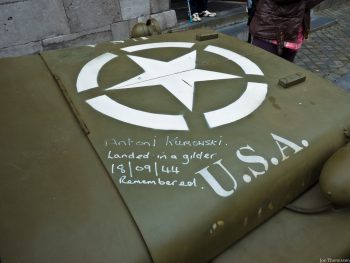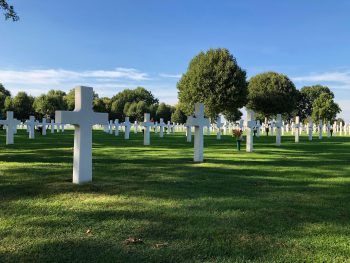Dutch Limburg Celebrates 75 years of Liberation Posted by Karoly Molina on Sep 18, 2019 in Uncategorized
Belgium and the southern provinces of the Netherlands are celebrating 75 years of Liberation. In Dutch Limburg, there have been events in several towns and cities celebrating on the exact day they were liberated with parades, concerts and more.
Geschiedenis
On May 10th, 1940, despite staying neutral in the war, the Netherlands was invaded by Nazi Germany. After five days of heavy fighting and bombing, the Netherlands surrendered or capituleerde and the royal family fled to England and Canada for safety. The first year of bezetting or occupation was mild (compared to the latter). As Germany needed more money and resources from the occupied countries, the invaders grew more brutal leading up to the last year of occupation which was perhaps the bloodiest and harshest.
The hardships of the Nazi Invasion are difficult to put into words. Men were required to work in the Germany factories throughout the country facing hard conditions and possible bombing by the Allies. There were a few work camps established in the Netherlands, mostly as transit camps, including Westerbork, Kamp Vugt, and Kamp Amersfoort. It is estimated that about 70% of the Jewish population was killed. When Allied forces were closing in on the Netherlands, some Nazi soldiers saw this as a moment to flee while others as a moment to do even more harm. The Dutch resistance fought long and hard throughout the entire occupation despite the brutal reprisals from the Nazi soldiers.
On September 12, 1944, Allied forces reached the village Mesch in Limburg and two days later Maastricht, the capital of the province. The goal of the allies was to take control of both the river Meuse or Maas and the Rhine or Rijn. By September 17, forces were in the Arnhem and liberation seemed to be a sure thing. Unfortunately, the Allies were unsuccessful in their mission and had to retreat. The months that followed are known as the hongerwinter following the blockage of food and supplies by Nazi forces. On February 1945, Allied forces were finally able to defeat German forces, cross the Rhine River and head to Germany to end the war. Canadian forces stayed behind to liberate the rest of the country, and on May 5th, 1945, the Netherlands was fully liberated. The video below explains a bit of the history I mention above.
Limburg’s Liberation
Although Limburg was liberated almost a year before the rest of the country, the hongerwinter still hit the province hard. The liberation of the southern provinces, however, was a glimmer of hope that the end of the war was soon to come.
This year marks the 75th anniversary of the Liberation and the province is celebrating big. Since 2006, the regional orchestra, philharmonie zuidnederland together with the American Cemetery in Margraten and other partners, organize a concert to thank the thousands of soldiers who sacrificed their lives. During this year’s ceremony, a flame of hope was brought by a group of athletes who walked from Caen in Normandy to Margraten, following the steps of the thousands of soldiers who marched across France, Belgium and the Netherlands. The U.S. Ambassador to the Netherlands, Pete Hoekstra, gave a moving speech centered on the idea all American soldiers had at the time: I just want to make it home. Although many of these young soldiers didn’t make it, the people of Limburg have provided them a home in the American Cemetery in Margraten where they are welcome and taken care of.
Visiting the American Cemetery in Margraten was incredibly moving. More than 8,000 American soldiers rest in a place of honor and with the highest gratitude. Families of Limburg have adopted the graves regularly bringing flowers and keeping the memory of these soldiers alive. During this year’s concert, philharmonie zuidnederland accompanied by the Brabant Choir played the 2nd Symphony by Gustav Mahler, a composer from the 19th century whose music was banned by the Nazis because of his Jewish background. The symphony, also known as the Resurrection Symphony, has a beautiful chorus at the end that talks about not dying in vain, you will rise again and that which hurt you will carry you to God.
The following video is part of the project called Faces of Margraten or De Gezichten van Margraten. This project is meant to give a face to the thousands of names at the American Cemetery with photos and stories of who these brave soldiers were. The following video explains this project further.
Have you visited some of the American Cemetery’s in Europe? How would you pay tribute to those who sacrificed their lives?

Build vocabulary, practice pronunciation, and more with Transparent Language Online. Available anytime, anywhere, on any device.





